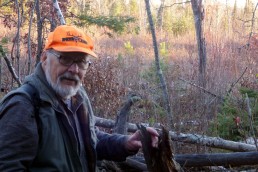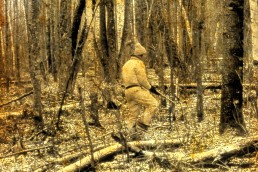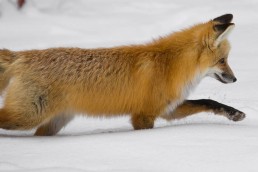Hunting Whitetails from a Pop-up, Tent-like Ground Blind
SHARE THIS POST
Whitetail hunting is certainly changing. As I’ve been encouraging hunters to do since 1990, many are now successfully stand-hunting at ground level. One of the relatively new innovations intended to help improve ground-level stand-hunting is a camo-covered, one- or two-man tent-like enclosure with wrap-around windows and a door, referred to as a ground blind. Most are lightweight (20 pounds) and easy for one person to erect or take down quickly. I personally intend to purchase my first one soon. I am most impressed at the moment by excellent dark camo on ground blinds featured in one of my favorite hunting and fishing catalogs.
Getting the most from such a blind is not simply a matter of setting one on the ground in the woods. Whereas the one great advantage provided by such an enclosure is making the hunter’s silhouette and motions almost invisible to nearby whitetails, few if any deer will be seen if the blind is not located within sight downwind or crosswind of trails and/or feeding areas currently favored by unsuspecting or unalarmed whitetails. Even then, where a ground blind itself is clearly visible to man or deer (despite wonderful camo) because its unnatural, cube-like form is not at least partially masked by intervening trees, brush and/or deep grasses, the odds of taking a mature whitetail from one won’t be particularly great. Another thing to keep in mind is such a blind is not “invisible” to a whitetail—or it’s nose. The hunter, who is seen, heard and/or smelled by a whitetail (not a fawn or yearling) while setting up such a blind, will not fool that whitetail. It will know exactly where the hunter is located, making it easy for the deer to avoid being seen, without the hunter’s knowledge.
Typically wanting a clear and wide field of view, stand-hunters almost routinely hunt at very edges of openings, clearcuts or farm fields. Last November, two mature does again proved to me why this is a mistake. By the time I spotted their heads in dense cover at the eastern edge of the opening before me (loaded with their favorite browse, red-bark dogwoods), they already had me pegged, likely having spotted my head move—despite wearing a camo head net—at the top of my natural brush blind at the southern edge of the opening. About 50 yards away, they stared at me without motion so long that I began to wonder if I was actually looking at deer. Then, suddenly, they were gone. One half hour later, the same two does unexpectedly sprinted across the opening from the west. While heading back to camp at about 11 a.m., I discovered their fresh tracks (in snow) in my tracks I had made earlier. They had headed west, passing directly downwind of where I had been sitting (identified me via their noses). About 100 yards west they had turned north toward the spot from which they made their mad dash across the feeding area.
By far, the best natural blinds I have ever used at clearcuts were well hidden and 15 to 25 yards back in the surrounding woods. Though deer (bucks) were seldom seen at these blinds until within 50 to 75 yards out in the opening, natural shooting lanes in the woods eventually provided easy shots at them. None of the many edge-of-clearcut blinds we have used during the past decade have ever provided opportunities to take mature bucks. Several of our back-in-the-woods blinds, on the other hand, have provided multiple opportunities to take mature bucks during succeeding hunting seasons. Don’t waste valuable time stand-hunting in blinds at edges of clearcuts or feeding areas, likely ruining such areas for hunting for the balance of a season in the process. Instead, always hunt from a blind hidden by natural cover back in the woods. Also, always place your blind within easy shooting distance of very fresh tracks and/or droppings of walking (not trotting or bounding) deer. Wherever you find very fresh tracks or droppings, always assume whitetails are near or soon will be. Always place your blind downwind or crosswind of these. Deer likely being near, you must then be capable of setting up your blind quickly and silently—repeatedly practice doing this in your backyard before a hunting season begins.
Are you enjoying this post?
You can be among the first to get the latest info on where to go, what to use and how to use it!
When a mature whitetail is near, silence is golden. You must therefore be able to open windows of your blind without telltale noise (no zippers or Velcro). While a window is open, of course, a nearby whitetail is likely to see you move inside while preparing to fire. Moreover, your bare human skin will be particularly visible. Therefore, always move very slowly when a deer is near and wear dark gloves and a camo head net, even while seated in a camo-covered blind.
With a big buck standing close to your blind, shooting off-hand is going to be difficult; your scope’s crosshairs or open sights will be wandering all over the place. In a blind, therefore, it would be wise to steady your aim with a bipod or tripod rest, or simply take two or three stout sticks of proper length tied together near one end. Open windows are unnecessary on some blinds, as having shoot-through fabric or plastic windows can be replaced later. Not a bad idea.
One of my daughters and her husband and two of my sons use portable blinds that must be hand- carried. With a rifle in one hand and a flashlight in the other, this can be cumbersome. I plan to attach my blind to my backpacked hunting stool (with a blaze-orange square of fabric hanging down over it), keeping my hands free.
Do it right and chances are you’ll soon consider your portable blind to be one of your most valuable deer hunting tools. MWO
MWO
SHARE THIS POST
Did you enjoy this post?
You can be among the first to get the latest info on where to go, what to use and how to use it!
Dr. Ken Nordberg
Based on his 55 years of field research, Dr. Ken Nordberg has written more than 800 magazine articles, 12 books on whitetails—including the famous Whitetail Hunter’s Almanac series—five books on black bear hunting and produced Buck and Bear Hunting School videos. You may peruse his encyclopedic website with whitetail hunting tips: drnordbergondeerhunting.com, his blog: drnordbergondeerhunting.wordpress.com, or social media pages.



